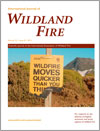International Journal of Wildland Fire
Volume 22
Number 8 2013
This study compares the relative accuracy of two fire-scar sampling methods for reconstructing fire frequency parameters in south-western ponderosa pine forests: (1) search-based sampling (i.e. ‘targeted sampling’); and (2) systematic sampling (i.e. ‘probabilistic sampling’). At all three of our study areas, we found that targeted sampling produced comparable estimates of fire frequency summary statistics to probabilistic sampling, without any major biases.
Climate models indicate that the climate of the south-eastern US will experience higher temperatures and associated evapotranspiration in the 21st century. This study showed that conditions in the south-eastern US will likely become drier overall, given a warmer environment in future winter and spring seasons.
Summary: Repeated lava-ignited wildfires resulted in reduced survival of native tree canopy Metrosideros polymorpha and tree fern subcanopy Cibotium glaucum and promoted the rapid occupation by aggressive herbaceous species. The expected consequence is a delay in, or prevention of, recovery to native Hawaiian mesic–wet forest dominance.
We compared vegetation recovery in grasslands affected by fires of different severity. Low-severity fires increased diversity, whereas high-severity fires reduced vegetation cover, with the exception of fugitive species. Tiller production of dominant tussocks decreased due to bud bank mortality and, in the seed bank, high-severity fires increased exotic species.
We investigated the short-term (up to 60 days) fire effects on small rodents and their relation to feeding habitats in the fire-prone Brazilian Cerrado, the most species-rich savanna in the world. The four most common rodents, mainly Calomys expulsus (the temporary post-fire dominant species), increased their invertebrate consumption in the burned areas.
Pyrogenic carbon (PyC) is a fairly stable form of organic carbon produced by fire with relevance for the global carbon cycle. We tested the widely held assumption that substantial amounts of PyC produced during a wildfire are consumed in subsequent fires using charcoal from a slash pile burn exposed to an experimental boreal ‘wildfire’ and found losses to be rather limited.
This study investigates the distribution of ash, soot and char that are generated from wildfires and migrate into adjacent residential regions. The results showed that the magnitude of the deposition on residential buildings near wildfires is dependent on a variety of variables, in particular the distance from the centre of the fire.
The spatial and temporal variability in fuel loads and moistures were quantified in non-native invasive guinea grass ecosystems in Hawaii. Fuel loads and fuel moisture, the primary drivers of fire occurrence and behaviour, varied tremendously spatially and temporally, and were strongly influenced by 7-day antecedent weather. This information can inform management and research on fire potential and behaviour in non-native tropical grassland ecosystems.
Three common down dead woody surface fuel sampling methods (planar intercept, fixed-area microplots and photoloads) were compared against reference fuelbeds spanning four loadings (0.05 to 0.2 kg m–2) to evaluate their ability to accurately estimate fuel loadings.
Pre-wildfire thinning and fuel reduction treatments increased tree survival compared with untreated sites following the 2002 Rodeo–Chediski Fire. A decade later, treated sites have stand basal areas that fall within target ranges for increasing resiliency to future fires. Surface fuels were within acceptable levels and are unlikely to increase substantially.
Fuel treatments are widely used to reduce wildland fire risks, but it is difficult to determine where, when and how to implement fuel treatments across a large forest landscape. We developed an optimisation model that schedules fuel treatments across time and space to improve the effectiveness of treatments.
We know that Community Wildfire Protection Plans (CWPPs) contribute to wildfire mitigation and preparedness, but do they make a difference for response and recovery? In a study of four USA communities, we found that CWPPs can contribute to response and recovery, and, coupled with the wildfire experience, build community capacity, resilience and adaptive capacity for future environmental change and disasters.
Aerial suppression drops aim to reduce fire spread. This paper presents criteria and methodology for measuring drop conditions and evaluating effectiveness. The analysis of orthorectified airborne infrared imagery is recommended for measuring drop location, dimensions and their effect on fire spread.
Efficient management of wildland fire requires knowing the costs that fire imposes on non-market uses such as recreation. This paper presents a new method for estimating the economic effect of wildfire on recreation using long-term datasets on fire locations and national park visitation in the United States.




